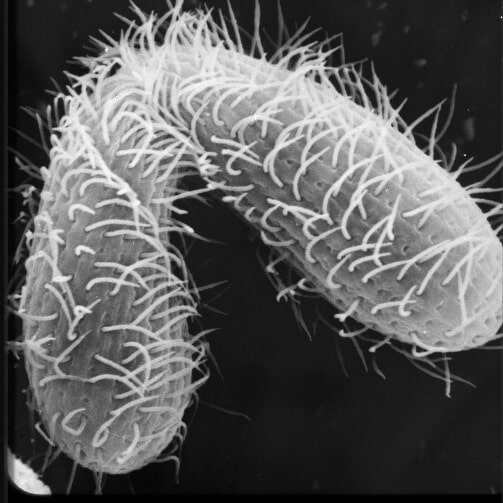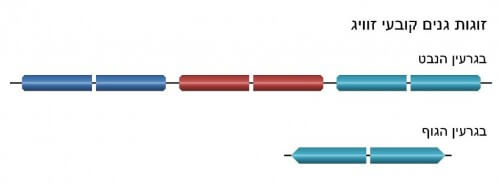The freshwater unicellular creature has seven randomly determined species
By: Noam Levithan and Yonat Ashchar

Many creatures are divided into two pairs (species): male and female. Sometimes the mating characteristics appear on a single individual, as in some plants and molluscs, and sometimes on separate individuals, as with us humans. Bisexual organisms can reproduce asexually only through sex with the opposite mate. A woman, for example, is unable to bring offspring into the world without a man being involved in the matter, and vice versa; And if getting along with two couples is sometimes complex and complicated, what would Harisnit say (Tetrahymena thermophila), her seven pairs?
Tetrahymena is a ciliate - a single cell covered with cilia that lives in fresh water and reproduces mostly by asexual reproduction, by division. Asexual reproduction has several advantages, including the transfer of all the mother's genes to the offspring, as well as saving on the need to search for partners. But these advantages also have a price - a lack of genetic diversity. This variation, which is created in sexual reproduction during mating - that is, when the genes from the parents are mixed - helps to deal with parasites and with changing environmental conditions. Indeed, in stress situations, when the environmental conditions change for the worse, as in the case of a lack of food, the tetrahymena switches from unisexual reproduction to reproduction that includes mating.
One of the characteristics of Tetrahymena, as well as other ciliates, is that it has two nuclei, one large and one small. The small nucleus, called the germ nucleus, includes the tetrahymena's genome, which is arranged in five chromosomes and each chromosome appears in two copies (diploid). This nucleus is normally inactive, and comes to life only in the case of mating. The large nucleus, the nucleus of the body, includes most of the genome of the iris, and is divided into very many chromosomes, about 225, which appear in many copies. The genome in this nucleus is active and responsible for all the operations of the tetrahymena: it is the one that codes the creation of more than 27 thousand proteins, is involved in asexual reproduction, and determines to which pair - out of seven possible pairs - the particular tetrahymena belongs.
How is the pairing determined?
Already in the fifties of the 20th century it was known that when the tetrahymena mates, it does so as one of seven pairs, where each pair can mate with any of the other six pairs, but not with itself. The mate of each of the two resulting offspring can be any of the seven possible, regardless of the mate of the parents. Marcela Cervantes (Cervantes) from the University of California at Santa Barbara and her colleagues from the United States and China discovered, in an article published in the online journal PLOS Biology, how the pairing of the offspring is determined.
In the mating process of the tetrahymena, called conjugation, two cilia from different partners adhere to each other and connect, and the germ nucleus of each of them divides by reduction division and becomes two daughter nuclei each containing only one set of chromosomes, whose role is similar to that of our sperm and egg cells. One such daughter nucleus passes from each tetrahymena to the other tetrahymena, and fuses with the daughter nucleus that remains there, to obtain the zygote nucleus - which is the equivalent of a fertilized egg. At the same time, the nucleus of the body of each cilium disintegrates and is destroyed. At this stage the cilia separate from each other and the zygote nucleus divides to receive a new germ nucleus, which includes all the genetic material of the tetrahymena, and a new body nucleus, parts of whose genetic material are removed and deleted and others rearranged.
The researchers discovered that this rearrangement determines the pairing of the cilia, in a process that is mostly random. They saw that in the nucleus of the germ there are pairs of genes arranged head to head and grouped together one after the other, with each pair representing one of the couples, but the genes are not complete. In the nucleus of the body, however, there is only one complete pair of genes. When a new body nucleus is formed, the gene pairs are cut and removed from the genome, each time a randomly chosen pair, until finally only one pair remains. The missing parts connect to this pair, to obtain complete genes that can be expressed and determine the mating of the tetrahymena, regardless of the mating that her parents had.
Mating determination in Tetrahymena. In the germ nucleus there are incomplete pairs of genes. In the core of the body there is one complete pair. This pair is obtained after the other pairs have been eliminated at random and is the one that determines the pairing.

Cervantes and her colleagues hypothesize that the proteins, the products of the genes that determine the pair, are found on the surface of the iris cell, so that other irises that meet it will be able to identify the pair to which it belongs, in a similar way to the way our body's cells distinguish between a self cell and a foreign invader. In their opinion, the study of tetrahymena can teach about the way in which reorganization of the genome occurs, a process similar to that which occurs in some cells of our immune system. He can also add new details about the way in which the ability to differentiate between self and stranger developed and works, which is important and related to autoimmune diseases and transplant rejection.
Galileo magazine as a gift! Click here to receive the benefit
regenerate or die
The Doctor, the hero of the series "Doctor Who", is a race of Time Lords capable of regeneration as a way to escape death. As a result of the regeneration the Doctor's body changes, he becomes young and healthy again and old and new character traits are destroyed and redistributed. During mating, the tetrahymena goes through a similar process; At the beginning of mating, two mature ciliates cling to each other and at the end, two young ciliates separate from each other - the offspring.
The process of mating, sex, and the process of reproduction occur separately in ciliates and in most other single-celled creatures. The tetrahymena - like other ciliates - reproduces by division, asexual reproduction, which means it brings new offspring into the world without the need for mating. But she and her offspring age over time, with each generation older than its parents, until after several hundred ciliary divisions they cannot function. The only escape of ciliates from this fate is mating, which is the process in which the genetic material of two different ciliates merges and mixes (without division). At the end of the mating, as mentioned, two young and renewed ciliates are obtained that can continue to reproduce in asexual reproduction - a kind of adult-only version of "Doctor Who", a version that would probably have pleased Captain Jack.
The updated article appears on Dr. Noam Levitan's blog SciPhile. The original article was published in Galileo magazine issue 177, May 2013
for further reading
The original article:
Cervantes, MD et al. Selecting one of several mating types through gene segment joining and deletion in Tetrahymena thermophila. PLoS Biol. 11, e1001518 (2013). doi: 10.1371/journal.pbio.1001518
The comic Sci-ence, by Maki Naro, about tetrahymena and the difference between sex and gender.
More on Galileo:
* Research: How can dietary fiber prevent stroke?
* Watch: A sea monster with three hearts and an eye with a diameter of 30 cm

One response
The pairing mechanism - very beautiful; But what is the essence of the seven pairs and what does each pair express and in general - what is seven pairs good for and what is the evolutionary mechanism that led to this.